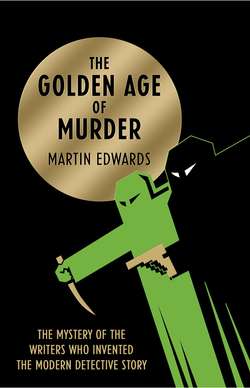Читать книгу The Golden Age of Murder - Stephen Bach, Martin Edwards - Страница 20
Notes to Chapter 2
ОглавлениеMy account of Sayers’ life and work owes much to information supplied by the Dorothy L. Sayers Society, Sayers’ reviews of detective fiction, and the biographies and collections of letters mentioned in the Select Bibliography, in particular Barbara Reynolds’ Dorothy L. Sayers: Her Life and Soul, together with material held in the Sayers Archive at the Marion E. Wade Center, Wheaton College, Illinois.
One successful Golden Age suspense novel (written by a single woman) even saw a deranged serial killer decide to solve that problem by ridding the world of unmarried females.
To identify the book in question would be too much of a spoiler, but the author was Ethel Lina White (1876–1944), a specialist in ‘women in jeopardy’ novels, and best known for The Wheel Spins (1936), filmed by Hitchcock as The Lady Vanishes. Raymond Chandler co-wrote the screenplay for The Unseen, also based on a White novel, Midnight House (1942).
the Sexton Blake series
Blake was another private eye with rooms in Baker Street; he was originally created by Harry Blyth in 1893. The many later, often pseudonymous, writers of Blake stories (Margery Allingham may have been among them) included the science fiction and fantasy novelist Michael Moorcock (born 1939) whose first Blake story, Caribbean Crisis (1962), a locked room mystery with a corpse in a bathysphere, is now a sought-after rarity. Blake was brought to the television screen in the Sixties, with Laurence Payne (1919–2009) in the title role; Payne later wrote crime novels, starting with The Nose on My Face (1961), a whodunit filmed as Girl in the Headlines.
Philip Guedella, a Jewish historian
Guedella (1889–1954) was a barrister and popular writer who stood five times as a Liberal candidate for Parliament without success. His epigrams include ‘Even reviewers read a Preface’, while his remark about detective stories is quoted in Antony Shaffer’s play Sleuth.
The Daniels puzzle remained unsolved.
Three years later, a workman called Prudhomme was interrogated by police after his wife accused him of stealing a gold watch, which was discovered at his home. But the watch proved not to be May Daniels’, and justice went no further than seeing the French police charge Prudhomme with the theft of a bicycle, and his wife with stealing vegetables.
a projected book about Wilkie Collins
The surviving fragment was published posthumously: E. R. Gregory, ed., Wilkie Collins. A Critical and Bibliographical Study (Toledo: Friends of the University of Toledo Libraries, 1977).
Clouds of Witness was most notable for a trial scene in the House of Lords
Charles Parker mentions to Wimsey the real-life precedent of Earl Ferrers, the last peer to be hanged, in 1760 (for the murder of his land steward). The novel achieved a strange form of notoriety in 1962, as one of the library books mischievously vandalised by the playwright Joe Orton and his lover and eventual murderer, Kenneth Halliwell; the pair were sent to prison for malicious damage to the property of Islington Public Library.
George Orwell (who had spoken of Wimsey’s ‘morbid interest’ in corpses)
In ‘Raffles and Miss Blandish’, Horizon, October 1944. Drawing a contrast with the stories about Holmes, Ernest Bramah’s blind detective Max Carrados, and Dr John Thorndyke, Orwell argues that: ‘Since 1918 … a detective story not containing a murder has been a great rarity, and the most disgusting details of dismemberment and exhumation are commonly exploited.’ A modern perspective is supplied in Jake Kerridge, ‘Does Crime Writing Have a Misogynistic Heart?’, Daily Telegraph, 17 July 2014. Thanks to the success of the Carrados stories, Ernest Brammah Smith (1864–1942), who wrote as Ernest Bramah, was an obvious candidate for membership of the Detection Club, but although he corresponded amiably with Sayers, probably his natural reclusiveness led him to decline the chance to join.
under the new imprint of Victor Gollancz
Details about Gollancz’s life and career are drawn from Ruth Dudley Edwards’ Victor Gollancz: a Biography (London: Gollancz, 1987).
influenced by Wright and Wrong
The seminal essays were Willard Huntington Wright’s ‘Detective Story’ in Scribners, November 1926, and E. M. Wrong’s ‘Introduction’ to Crime and Detection (London: Oxford University Press, 1926).
